|

Excerpt from
an Article by Michael E. Salla, PhD
from
OpenSETI Website
The scientific and engineering building
blocks that form SETI's intellectual foundation and technology
consist of:
-
Newtonian physics
-
Darwinian evolution
-
Maxwellian electromagnetic
theory
-
classical radio technologies
developed in the 1940s and 1950s
-
the Oparin-Haldane hypothesis of
the synthesis of life from prebiotic soup and lightning
(1950s)
-
the Fourier transform and Fast
Fourier Transform algorithms first used on computers of the
1960s and 1970s
-
very-large-scale integrated
circuits of the 1980s
-
parallel processing (1980s)
-
distributed computing over
today's Internet, as in
SETI@Home
Thus the SETI paradigm is a kind of
Frankenstein's monster of old body parts collected from the last two
centuries that somehow walks and talks but cannot align with the
world in which it now finds itself.
Recently, SETI has attempted to get more in synch with current
issues in astrobiology, and now considers that life - even DNA-based
life due to
Panspermia mechanisms - may be much more pervasive than
originally thought. But if life is more widespread than SETI
thought, so might be intelligent life and technological societies.
This possibility is rarely acknowledged in the halls and annals of
SETI.
Nor does SETI reflect the implications of post-Newtonian (i.e.,
twentieth-century) physics for the prospect that we and other
societies could achieve interstellar travel - even now that we have
entered the twenty-first century and society's horizon of the
possible is rapidly expanding.
Why does SETI hold so to its rigid paradigm? Perhaps because it
cannot face the prospect of changes that could undermine the very
reason for its existence.
The Plan for
this Page
Open SETI Physics 101 reviews elements of physics that have
received widespread attention if not full acceptance, but that
appear so far to have been ignored by SETI. But beyond that, new
formulations of physics itself are on the horizon. These hold
promise of completely replacing today's ideas of the nature of
reality.
Two such new formulations are introduced on this page, with links to
resources that fully explain them. The physics of Don Hotson
is discussed under the heading Zero-Point Energy, Part 2
(below).
A discussion of Subquantum Kinetics
(far below), an important new physics developed by
Paul A. LaViolette, appears at
the end of this page. Each of these proposals contains many
considerations that would require revising not only Open SETI
Physics 101, but much of Open SETI, let alone SETI, and
widespread areas of science and technology as well.
However, for the
moment, the two bodies of ideas remain somewhat encapsulated until
better understanding has been gained of their implications vis a vis
each other and the Open SETI paradigm.
That said, let us now look at some areas of more mainstream physics
that will have implications for SETI.
Extra
Dimensions
Dimensionality beyond our familiar 4-D spacetime has long been a
staple of science fiction, the dream of science "buffs", and the
framework for "the other side" where people go after death, shamans
travel, the soul resides, and UFOs fly when we can't see them.
Not that the idea of extra dimensions is without support from
mathematics and physics. The mathematical basis is certainly there,
and modern
superstring theories require 10
spatial dimensions. In these theories, all the matter and forces
that we know of, with the exception of gravity, are constrained from
moving into the extra dimensions, or from them into our own
spacetime.
That is why we cannot see them.
But could we at least see gravitational effects leaking across from
other dimensions? It is possible that we DO see them! Gravitation
from matter in the extra dimensions could explain the mystery of the
"dark matter" that seems to make up 90% of the mass of the universe.
To move these speculations into the realm of experiment, physicists
would like to examine the structure of gravitational forces and/or
observe the quantum behavior of the strings that have their basis in
the extra dimensions. Until recently, however, their problem has
been that the extra dimensions were thought to be "curled" into tiny
circles too small to be observed.
(If "curled dimensions" are hard to
imagine, consider that our own spacetime has often been considered
to be "curved" by gravitation - closed so as to encompass a limited
size to its geometry. The extra dimensions were conceived to be
closed in the same manner.)
The small size would mean that the
structure of gravitational forces is far too small for our
experimental devices to work with, and that particles corresponding
to that size would be far more energetic than any we could create
with existing or planned colliders.
But in new theories gaining support today, the extra dimensions are
wrapped into circles as large as a millimeter in radius. That seems
small but it is actually large enough to come within range of, for
example, the
Large Hadron Collider that will
become fully operational in 2008.
Tabletop gravity experiments are
now underway.
The small size of the extra dimensions in no way limits the extent
of the spacetimes that would connect to any of them.
At any given coordinate along one of the
dimensions, an entire 4-dimensional spacetime could exist, as well
as parallel universes with dimensional systems utterly unlike our
own. In one scenario, they would have properties identical to those
of our own world. Or they could even BE our own world, folded back
at some point practically unreachable from here, yet only a
millimeter away in higher-dimensional space.
The implications for SETI of these intriguing new geometries are
obvious. SETI scientists ought to watch these developments closely,
because they suggest new possibilities for travel and
communications.22
Zero-Point
Energy, Part 1
SETI scientists frequently cite the enormous amounts of energy that
would be required to accelerate a space vehicle to near-light
speeds.
Figures are often quoted in terms of years of total U.S.
energy output, as though to demonstrate the practical impossibility
of interstellar space flight.
Yet for at least as long as SETI scientists have been invoking the
scarcity of energy, physicists have accepted the concept of
"zero-point"
energy (ZPE) (also known as "vacuum fluctuations"). This
refers to enormous amounts of energy associated with the minimum
quantum state of atoms at absolute zero temperature.
The average energy is E = hn/2, where h
is a constant from quantum theory, known as
Planck's constant; n refers to
frequency.
Can this energy can be tapped? The possibility is under intense
investigation.
Rather than attempt to review this subject here, I direct the reader
to a review and tutorial
Understanding Zero Point Energy by
Tom Vallone, Integrity Research Institute.
Also see Puthoff (Puthoff, H.E., 1998,
Can the Vacuum be Engineered for Spaceflight Applications?
Overview of Theory and Experiments. Jour. Sci. Exploration 12:
295-302.
Originally presented at the
NASA Breakthrough Propulsion Physics Workshop,
NASA Lewis Research Center, Cleveland, OH, August 12-14, 1997) on
laboratory investigations of experimental formats for tapping the
ZPE for practical use.
Zero-Point
Energy, Part 2
That was the conventional approach to ZPE.
The subject is cast quite
differently by
Hotson
(2002), who takes us back to 1934, when the physics community was
having difficulty understanding the physical meaning of P.A.M.
Dirac's (1928) relativistic generalization of the Schrödinger wave
equation.
The equation gave four solutions instead
of the expected two, seemingly calling for electrons and positrons
of positive energy, and electrons and positrons of negative energy -
whatever that might be. Through lines of reasoning retraced by
Hotson, physicists concluded that the equation would require the
existence of a "sea" of negative energy electron-positron pairs
(epos), and they then did away with the troublesome negative energy
sea by means of dubious rationalizations.
This resulted in a
description of a universe that more or less matches the one we live
in, but one that must contain behaviors that we normally don't see,
such as the vacuum fluctuations.
Hotson explores the results of retaining the full set of solutions
to Dirac's equation.
As he explains, there should be no
problem in understanding the meaning of the negative-energy epos,
given that their vibration is assigned an imaginary direction (i.e.,
orthogonal with respect to our four).
He shows in
Part 2 (2002) that the "sea"
resembles a vast Bose-Einstein Condensate (BEC), and the total
solution predicts and explains numerous properties of our observed
reality that have been considered anomalous in the present
description.
In a March 16, 2005 letter, Hotson points to recent developments
supporting his BEC theory:
"You will recall that the Dirac
'cosmology' depends on a single premise: that the Dirac equation
mandates that the 'vacuum' actually be a Bose-Einstein
Condensate (BEC) consisting of condensed epos, which form the
sole 'building blocks' of the universe.
"Some new evidence has emerged that demonstrates exactly that.
Dr. Benni Reznik of Tel Aviv University has published a series
of papers showing that the 'vacuum' itself is entangled, that
points arbitrarily far apart in the 'vacuum' violate Bell's
Inequality, and that two unentangled probes, launched into the
'vacuum', rapidly become entangled themselves. He says that the
'vacuum' actually operates as if it were a BEC."
Reznik's research will be reviewed by
Open SETI at a future date. Meanwhile, an abstract with links to his
papers on quantum entanglement
may be viewed here.
Hotson points out that the negative BEC would interact with plasmas
to create behaviors that have been observed but not up to now
understood. And in effect, these behaviors represent a drawing out
of energy from the negative BEC. In other words, ZPE is being
extracted from the sea, and it happens all the time in macroscopic
systems that we can observe, such as in the Sun and the large
gaseous planets of our solar system.
Astonishingly, Hotson explains with
numerical solutions the "resonances" between planetary bodies long
observed and never really understood by planetary astronomers. These
effects are the result of perturbations of the BEC's wave function
on the scale of the solar system.
And finally, this is important for Open SETI, because the planetary
processes once understood could be copied and employed by space
hardware for propulsion and many other applications.
Interstellar
Travel at Subluminal Speeds
Candidate Propulsion Systems for Interstellar
Travel
SETI's dour outlook on the prospects for
interstellar travel has apparently not discouraged the aerospace
community from actively beginning to outline engineering
requirements and develop the concepts for propulsion and other
enabling technologies.
To demonstrate this fact, I had a link
on this page to an excellent review of "Advanced Propulsion
Concepts" - mission requirements and propulsion options - on a JPL
page entitled "INTERSTELLAR
MISSIONS". Unfortunately JPL now blocks public access to
this information and to the image that used to appear in the space
above.
One propulsion method proposed for interstellar missions is that of
the laser light-sail, employing a solar-system-based laser, a very
large fresnel-zone lens, and a very large light-sail on the
spacecraft.
Robert Forward (1984)
describes a technique for achieving a round trip by deploying a
backward-reflecting ring-shaped sail beyond the destination star for
deceleration and the push for the return. The outbound leg to a
Centauri would take 41 years.
These are but a few of the plausible proposals for interstellar
travel. Readers interested in pursuing this subject further could
begin with
The Starflight Handbook (Mallove and Mattloff,
1989), covering propulsion and many other topics relating to
non-relativistic flight to the stars.
Antigravity
and Travel at Superluminal Speeds
"Advanced Propulsion" seeks to achieve speeds up to about 0.1 c -
one tenth the speed of light which was for most of the last century
considered an absolute limit on the motion of macroscopic objects.
But the speed of light no longer has that unassailable status. In
fact, a technology to support faster-than-light travel has been
proposed by Mexican physicist
Alcubierre (1994).
It would be accomplished by distorting
the local space-time metric in the region of a spaceship so as to
achieve motion faster than the speed of light as seen by observers
outside the disturbed region.
Hal Puthoff
(1996,1997,1998,2002) elaborates on the proposal with a discussion
of metric engineering, whereby the speed of light in free space c is
changed by modifying the magnetic permeability and dielectric
permittivity of the vacuum.
Another example of manipulating the spacetime fabric for purposes of
travel was described by Eric W. Davis in
Wormhole Induction
Propulsion (WHIP). The technique involves the generation of
ultra-high B fields through the use of chemical or nuclear explosive
technologies. According to Davis, laboratory experiments that can be
performed now have excellent potential of demonstrating the spacetime distortion required for this type of breakthrough
propulsion.
Continuing his studies of wormhole production via spacetime metric
engineering, Davis in a 2001 report,
Wormhole-Stargates - Tunneling
Through The Cosmic Neighborhood,
examined the morphology of traversable wormholes consistent with the
General Theory of Relativity (GTR), including "time machines"
with which he claimed GTR is "infested", and noted that many
reported behaviors of UFOs are fully consistent with the use of such
wormholes.
This work is updated by Davis in his
Teleportation Physics Study
(2004) report to the Air Force Research Laboratory.
An extract of
an article by Dr. Michael E. Salla
exploring the "exopolitical implications" of the report can be found
in the sidebar at the right. Open SETI is (Feb 2005) studying the
report for its many apparent relevancies to the Open SETI theme.
When complete, the results of this review will appear here. See also
time travel.
The possibility of manipulating gravity and altering mass (of
spaceships, say) as a means of reducing energy requirements for
space travel had been discussed in the open scientific literature
for many years.
For example, as early as 1963, Robert L. Forward
showed how Einstein's equations of general relativity predict that a
moving mass can create non-Newtonian gravitational forces on a test
body. Forward demonstrated how a massive rotating ring generates
forces similar to the familiar centrifugal and Coriolis forces.
In order to make practical use of these forces, very high masses or
densities would be required, as well as relativistic equatorial
velocities. Limitations in mechanical strength of materials could be
overcome by employing electric or magnetic fields to contain the
inertial forces. Forward proposed that manipulation of gravitation
by such means could lead to ways to accelerate space vehicles to
nearly the speed of light.
It should be pointed out that Forward's discussion was published
forty years ago in the open scientific literature.
Presumably work in this area has
continued. See, for example, a recent investigation by the Advanced
Concepts Office of the Propulsion Directorate of the Phillips
Laboratory at Edwards Air Force Base (Forward, 1996).
NASA
Breakthrough Propulsion Physics Project
In 1997 NASA held a
Breakthrough
Propulsion Physics Workshop to identify "affordable, near-term,
and credible research that could make measurable progress" toward
the achievement of breakthroughs leading to practical interstellar
transportation.
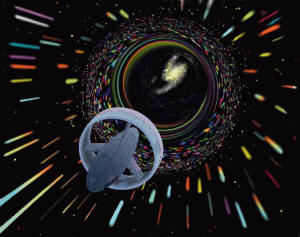
Artist's depiction of
a hypothetical Wormhole Induction Propelled Spacecraft,
based loosely on the
1994 "warp drive" paper of Miguel Alcubierre.
Credit: NASA
CD-98-76634 by Les Bossinas.
Topics discussed included coupling of
gravity and electromagnetism, vacuum fluctuation energy, warp drives
and wormholes, and superluminal quantum tunneling. See also NASA's
Breakthrough Propulsion Physics Project.
As a final example of a breakthrough propulsion proposal, see the
patent by James Woodward: Method for transiently altering the mass
of objects to facilitate their transport or change their stationary
apparent weights.
Woodward describes a tabletop experiment designed
to reveal mass fluctuations in
Mach’s Principle, Mass Fluctuations, And Rapid
Spacetime Transport.
Superluminal
Travel in a World without Einstein
Many readers will be shocked at the idea that Einstein's view of
relativity was utterly wrong and that the edifice of today's science
based on that view will soon fall.
Yet a little research reveals that
Einstein's "thought experiments" have never been supported by
real-world experimental data, and that they lead to unresolvable
paradoxes, the hallmark of a failed theory.
This proposition cannot be adequately discussed on the present web
page, and by me. But I can present a few highlights from an
excellent survey of the situation, presented by William Cantrell
(2001) in Issue No. 38 of
Infinite Energy, a special issue on the
topic "Einstein Reconsidered". (Note: I assume the reader is
familiar with the terminology mentioned in these points. Terms are
explained in the paper.)
Key points include:
-
Einstein, in connection with his
Special Theory of Relativity (SRT), did not independently
derive the Lorentz transformation that thoroughly
intertwined space and time. Rather, he tentatively selected
that transformation as an ad hoc approach to solving
problems presented by the Maxwell Equations.
-
There was trouble with this use
of the Lorentz transformation almost from the very
beginning. For example, the transformation relates to a
translation that is applied only along one coordinate axis.
But in the more general case of two linear, non-aligned
translations, the calculation of the transformation breaks
down; the results are dependent on the order in which the
two translations are applied. This is a paradox, an
absurdity.
-
The famous "twin paradox"
associated with SRT has never been resolved, particularly
not by the argument that the acceleration of one of the
twins breaks the symmetry. The reason is very clearly shown
in the paper.
-
There is a host of other
paradoxes associated with the Lorentz transformation. These
are mentioned in the paper. And there are other solutions to
the original problems with Maxwell's equations that avoid
these paradoxes
-
The behavior of particle clocks
is not as predicted by SRT.
-
If SRT fails, the speed of light
in a vacuum is not a constant and is not a barrier. In fact,
velocities in excess of 10c have been observed by
astronomers. Furthermore, gravity appears to act
instantaneously over distance, and NASA assumes this in its
calculations.
The final point above bears directly on
the possibilities for high-speed space travel. It suggests that
there is no fundamental limit on possible speeds.
General relativity presents its own problems. I have not yet
discussed these, but will include such a discussion later as time
permits.
Nonlocality
No discussion of the impact of current theories in physics on the
possibilities for SETI would be complete without a recognition that
various concepts of nonlocality arose in the last century, and
experiments verified that under certain circumstances
("entanglement"), faster-than-light interaction seems to take place
between physically separated particles - in violation of Einstein's
General Theory of Relativity.
Two very clear reviews and explanations
of this development are given by Gary Felder in his article
Spooky
Action at a Distance (Einstein's term) and David M. Harrison in
Bell's Theorem.
More recent experiments are beginning to suggest that this
"entanglement" effect can have real, macroscopic applications--in
other words, that superluminal communication might be supported.
But
vastly broader implications have been drawn.
Matti Pitkänen
in TGD inspired
theory of consciousness and biosystems as
macroscopic quantum systems and subsequent articles all in The
Journal of Non-Locality and Remote Mental Interactions (JNLRMI)
Volume I, Number 1, develops a view of biosystems as macrocosmic
quantum systems existing in a many-sheeted spacetime.
JNLRMI appears on the website
EmergentMind.org, a forum created by
Dr. Lian Sidorov, already containing many articles and other
contributions that bear heavily on SETI's theoretical underpinnings.
A technology based on nonlocality would be an obvious candidate for
supporting
Telepresence. (Quantum
entanglement may be vastly more "far-reaching" than we had
supposed.
For a review of important recent developments in our
understanding of quantum entanglement see the New Scientist
article
Entanglement: The weirdest link.)
Time Travel
A discussion of time travel may be accessed
HERE.
Black Special
Access Programs
The purpose of this page is to demonstrate how badly the SETI
program has misstated the possibilities for long-distance space
travel, which is crucially important to the development of the SETI
paradigm.
The list of topics obviously does not constitute more than
the briefest glimpse of present or contemplated state of the art,
but it should suffice to illustrate the problem.
The case would be even more strongly made, however, if some note
could be taken of "exotic" technologies that have been proven and
have achieved operational status, though they may not be discussed
in the scientific literature - perhaps not even as distant
possibilities. For now, such technologies are highly classified and
protected under the rubric of
Black Special Access Programs ("Black
Projects" or "Black Programs").
Many who have worked in such areas
have affirmed seeing things that are far in advance of anything
dreamed of in the unclassified world.
But what are these things and how can one approach knowledge of them
without actually entering that domain, and how then can they be
spoken of in the unclassified literature?
One person who has tried to solve that problem is Nick Cook, former
aviation editor of
Jane's Defence Weekly. Handed a photocopy of an
article about antigravity development from some old popular
magazine, Cook did a cursory check and found that there WAS a spate
of stories on the subject in the early 1950s, but all talk of
antigravity suddenly stopped in 1957.
Not really expecting to turn up anything more, Cook followed up what
few leads he had, working on his own time.
Early on in his research,
he encountered reports of the work of American physicist
Thomas
Townsend Brown (1929), who, as a student under the guidance of
physicist and astronomer Paul Alfred Biefeld, had discovered
that a plate-like object charged positively on one side and
negatively on the other would exhibit thrust in the direction of the
positive pole. This odd effect, which came to be known as the
Biefeld-Brown effect, had no explanation in conventional physics,
yet there it was.
Brown's experiments with "electrogravitation", as he called it,
continued under mirky circumstances -- likely under cover of
classification, yet official military pronouncements stated that the
propulsive effect was merely the result of the air currents or ion
currents generated by Brown's apparatus. Brown himself claimed to
have properly addressed and disposed of that possibility.
At any rate, in 1952, the Pentagon
declassified and released a document describing Project
Winterhaven, a proposal to develop an operational flight system
utilising the Brown effect.
Nick Cook, following lead after lead, eventually traced the
antigravity story to roots deep in the underground slave factories
of the Third Reich, and had surprisingly revealing interviews with
past and present research directors of the most advanced aerospace
development facilities in the U.S.
As he reports in his recent book, The Hunt for Zero Point (2001),
there is good reason to believe that Germany had made significant
progress in anti-gravity technology, and that their work was
transplanted to the United States and the USSR after the war.
Now how were the Germans, coming out of a deflationary depression,
and now under the stress of war, able to achieve any measure of
success with a technology so advanced as to appear little more than
a science fiction myth to most of us some sixty years later?
In my
opinion it was because of their willingness to support radical
departures such as the visions and ideas of the Austrian "forester"
Viktor Schauberger.

Viktor Schauberger
Schauberger developed his unusual
theories, which he turned into working machines, from observing
fluid dynamics in streams and rivers, watching how fish swim, etc.
He felt that he was seeing the manifestation of energy from these
motions that was not originally there. He seems to have been
correct.
By departing from the usual method of the development of scientific
ideas, Schauberger seems to have come across something that had been
totally missed. The phenomenon was real, but the basis of it was
unknown - probably to Schauberger himself as well as his peers and
definitely to his SS overseers. But he was taken seriously, not only
by the Germans, but by the Americans, who brought him over after the
war and essentially stripped him of all his work.
More about
The Hunt for Zero Point.
Is antigravity an operational military technology? Australian
aerospace engineer Malcolm Street suggests some versions of the
Joint Strike Fighter have it. His article,
Anti-gravity and us, is
controversial but provocative, and contains valuable links
(including pages of links) for further study.
And Dr. Paul A. LaViolette, using his principles of Subquantum
Kinetics, described in the next section, shows how the B-2 Stealth
Bomber may well employ electrogravitics as its primary means of
propulsion and perhaps directly for lift.
Subquantum
Kinetics
"Subquantum Kinetics is a serious
scientific study which examines the problem of the interaction
of solid bodies and electromagnetic fields with the physical
vacuum, taking into consideration an extremely large portion of
the theoretical and experimental knowledge of modern physics....
"There are grounds to recommend this monograph as a compulsory
textbook for students of the physical sciences because without
knowledge of the main aspects of subquantum kinetics, modern
physics will not adequately develop as a science and also
because the detailed understanding of physical phenomena and
their complex interrelations is a basic requirement for every
expert in the field of physics."
- from a review by Evgeny
Podkletnov
Russian scientist noted for work on anti-gravity
Infinite Energy Issue 54, 2004
The fundamental recognition upon which
Dr.
Paul A. LaViolette bases his
highly promising
Theory of Subquantum Kinetics (SQK) is that
general systems
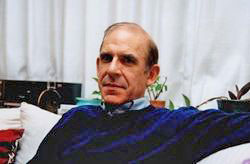 theory, which describes a common set of dynamic
interactions found in biological and social systems of every level
of complexity, might well be applicable to the world of subatomic
particles and whatever substrate may lie beyond the quantum level. theory, which describes a common set of dynamic
interactions found in biological and social systems of every level
of complexity, might well be applicable to the world of subatomic
particles and whatever substrate may lie beyond the quantum level.
LaViolette's approach is to adopt a widely-studied set of
three-variable dynamic equations describing an archetypal kinetic
system known as Model G, an extension of the two-variable
Brusselator, postulating that the same dynamics operate on the
subquantum level to generate the physical world that we can observe,
and to test his hypothesis by looking for conformity of the
resulting physics with what is accepted to be true, and to predict
the outcome of future observations and experiments.
In LaViolette's SQK model, the universe is an open system at all
levels, and our physical universe commonly exchanges energy across
the "quantum barrier" under certain well-defined circumstances.
This
is a profoundly non-conservative model (i.e., energy is not
conserved and the second law of thermodynamics does not apply) with
major implications for everything from microphysics to cosmology.
But what is the system beyond the quantum barrier (i.e., the system
out of which particles, fields, forces, charge, gravitation, all
arise to create the world described by physicists)? What is it that
would have the dynamic processes defined by the Model G equations?
LaViolette proposes the existence of a
primordial transmuting ether composed of populations of subtle
particles that he calls etherons exhibiting reaction and diffusion
dynamics governed by the Model G equations. Concentrations of these
etheron populations or substrates are identified with the potential
fields of physics. Wave-like field gradients form observable
quantum-level structures such as energy waves and subatomic
particles with mass, charge, spin, and force field effects.
From this simple basis, and some
fine-tuning of the model's parameters, LaViolette proceeds to -
apparently very successfully - crank out our familiar world.
Because it begins with a single model as its point of departure for
describing essentially all observable physical phenomena, SQK can be
considered a unified theory.
Can it truly be so? Can this approach work? In lesser hands,
probably not.
But with great competence and a sure
knowledge of the philosophy, history, and the classical and current
issues of physics, wonders unfold in succession. In his seminal
Subquantum Kinetics (2003) we are shown the structure of subatomic
particles and how they are created, the basis of photon behavior,
the internal electric potential field profile of the proton, the
nature of electrostatic charge and of gravity, solutions to
persistent problems in quantum mechanics... and this is only the
microphysical level.
SQK has tremendous importance in
cosmology leading to a new view of the cosmos.
Relevance of
New Physics
Are SQK and Hotson's physics relevant to SETI and Open SETI?
Of
course they are, if SETI has anything to do with physics at all. The
incorporation of new physics into the Open SETI paradigm will be an
important thrust in the development of this field.
For the moment, however, we leave you
with a teasing hint or two of what is to come:
-
Generating negative
gravitational fields (SQK)
-
Superluminal Non-Hertzian waves
(SQK)
-
The physical basis of time
anomalies (Hotson, articles listed on Open SETI home page)
SQK and
Gravitation
In SQK, gravitation is not a result of a warping of the space-time
continuum - which, in fact, SQK claims does not occur.
Instead, the gravitational potential
fields, as are other energy potential fields surrounding subatomic
particles, are generated by surpluses or deficits in the production
of etherons (G-ons in the case of gravitational potentials) at the
particles' centers with respect to the production rate in their
surroundings.
These surpluses or deficits, which LaViolette
identifies as active gravitational mass, are predicted by the
kinetic equations governing the SQK processes associated with the
particles.
SQK predicts that gravitational potential fields plateau to a finite
value at the center of subatomic particles, unlike the 1/r2
singularity of classical physics. There is also a 1/r4 "genic"
energy radiation pressure. Each of these effects eliminates the
possibility of gravitational collapse to a black hole under any
circumstances. In other words, there are no black holes in SQK-based
cosmology and astrophysics.
In a short two-page development, LaViolette finds that
gravitationally interacting matter particles would have a mutual
attraction, while antimatter particles would be mutually repulsive.
More precisely, positively-charged particles generate a gravity
potential well, while negatively-charged particles actually generate
a gravity potential hill.
In neutral matter, the effect of the
positive particles dominates, hence we see the familiar
gravitational attraction of matter.
However, in the case of
antimatter, with positrons (positively charged) and antiprotons
(negatively charged), antiprotons dominate gravitationally, and the
net gravitational effect is one of repulsion, suggesting that
antimatter stars and galaxies would be unable to form. In the case
of matter-antimatter gravitational interaction, the antimatter
particle would continually chase the material particle.
When a source mass is in motion, its gravitational force field would
contain some curl. In other words, gravitodynamic forces similar to
electromagnetic forces, only much weaker, are predicted by SQK.
Gravity experiments have demonstrated
the production of Hertzian-like gravity waves by a revolving mass,
which would be consistent with this prediction.
|
Nikola Tesla's scalar wave technology has been
suppressed and all but forgotten, but for legends that will not die.
But the social pathology of our human society may not be universal.
Why would other civilizations not
enjoy this technology?
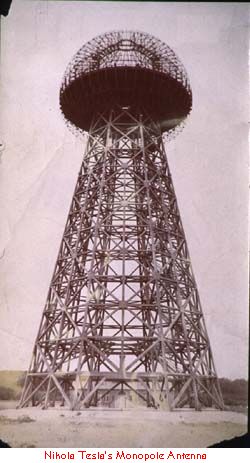
It is known that "Tesla waves" were
generated by sending very short, very-high-voltage spikes into
spherical monopolar radiators. The resulting Non-Hertzian or scalar
waves are fully described in
Paul LaViolette's Subquantum
Kinetics.
Being longitudinal waves, they do not
excite currents in ordinary antennas, and thus cannot be detected by
ordinary receiving systems such as the kind employed by SETI. While
their very existence is officially denied, detection by quite simple
receivers has been demonstrated. Furthermore, they can easily be
collimated, making them ideal for long-haul communications, possibly
over interstellar distances.
Can you think of any reason why the public would not be told of a
communications technology employing signals that are undetectable by
ordinary receivers?
Search the SETI literature for mention of scalar waves and you will
find nothing.
This is but another indication that
SETI is not serious about its work, preferring to adhere to official
agendas for public information and education.
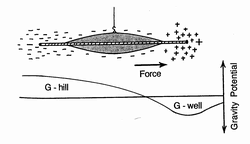
Brown Disk with
Gravity Potential
T. T. Brown's tethered disk showing charge clouds and
suggestive plot of gravitational potential, courtesy Paul. A.
LaViolette.
Brown claimed that the observed
propulsive force driving the disk was generated by an
electrostatic-gravitational interaction.
Though his demonstrations were
impressive, and probably stimulated classified military research,
neither Brown nor anyone else was able to satisfactorily explain the
interaction until it was recently predicted by LaViolette's
subquantum kinetics.

Flame Jets
B-2 showing charges emitted
by flame jets as interpreted by Paul LaViolette from information
disclosed in Aviation Week (1992). Courtesy Paul A.
LaViolette. Flame jets are jet engines with internal electrodes for
disbursing negative ions in the exhaust stream.
Positive charges are conducted forward
and distributed along the craft's leading edges. The electrogravitic
effect was not mentioned in the Aviation Week article.
|
SQK,
Electrogravitics, and the B-2 Stealth Bomber
The Biefeld-Brown effect is a straightforward prediction of SQK.53
As described by Paul LaViolette in "The U.S. Antigravity Squadron"
(1993), Brown's disks generated a cloud of positive ions ahead of
their leading edge, and a negatively-charged cloud behind the
trailing edge.
According to SQK, this places the disk between a
gravitational hill and well, and the disk continuously "falls
downhill" with the clouds following along.
Understand that the forces propelling the disk are a function of the
electrostatic potentials applied to the leading and trailing edges
of the disk and can be made arbitrarily high. In a 1952
demonstration for the Air Force, Interavia magazine reported that
tethered disks charged to several hundred thousand volts moved
around a 50-foot-diameter circle at speeds of several hundred mph.
It is also important to realize that occupants of craft propelled in
this way will be in free fall at all times and will feel no inertial
forces under any degree of acceleration.
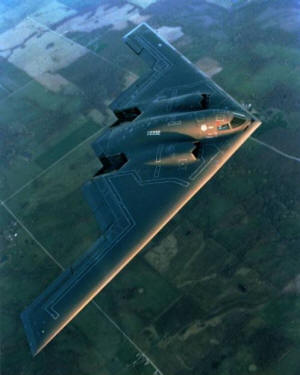
B-2 Stealth Bomber
LaViolette suggests that this propulsion
technology is by now highly developed and operational in U.S.
military aircraft - specifically the
Northrup B-2 Advanced
Technology Bomber - the stealth bomber.
Working with published
information about this aircraft, LaViolette reads between the lines
and develops considerable suggestive information about how the
technology may be being used, both for lift and thrust. He also
describes a zero-fuel operational mode with the craft powering
itself with "energy tapped from its self-generated gravitational
gradient".
For a full review of what is publicly known about antigravity
propulsion, see La Violette's
Secrets of Antigravity Propulsion
(2008).
The importance of all this to SETI should be glaringly obvious. It
is saying that we, today, possess technology that SETI does not ever
allow its target ET civilization to have. For example, SETI is fond
of saying that fuel requirements render interstellar travel
impossible.
What, we wonder, does our own Department of Defense think of the
SETI program?
SQK and Non-Hertzian
Potential Waves
SQK models radiant energy as a propagating electric potential wave
("scalar reaction-diffusion wave"), rather than as a propagating
electromagnetic force field wave (vector wave) of Maxwell's theory,
with its alternating electric (E) and magnetic (H) force field
intensities transverse to the direction of propagation.
SQK's electric potential wave has no magnetic wave component. In
fact, magnetic potential fields do not exist in SQK. The wave also
includes a gravity wave component.
These waves propagate forward because their field gradients extend
longitudinally, as two types of etherons are alternately compressed
and rarefied. In this they resemble sound waves, but these waves can
induce transverse forces on distant test charges if they have been
set up by charges moving transversely, because the motion of the
charges creates transverse potential gradients.
Thus these primarily
scalar waves can have the property of polarization. In that sense
they are Hertzian waves.
But SQK also predicts the existence of energy waves that are
primarily longitudinal. Such non-Hertzian waves would radiate from
an electrically charged sphere (a monopole antenna) with an
oscillating surface voltage - as in Nikola Tesla's "monopole
magnifying transmitter tower".
Since "Tesla waves" would be
incapable of accelerating charges transverse to their direction of
propagation, conventional radio receivers (such as operated by SETI)
would be unable to detect them. However, in a closed cavity, they
would be able to produce standing waves of electric potential.
Devices capable of detecting these waves have been demonstrated.
LaViolette gives a differential equation expressing Tesla-like
scalar potential waves propagating longitudinally through the ether
at a velocity that can be greater than c.
The point of discussing Tesla and electrogravitics on this page is
to show that these technologies are neither mysterious nor complex
in their basic principles. The reason there is little popular
understanding of them is simply that they have been suppressed, for
important strategic purposes.
That is also why SETI does not
consider them. Unfortunately, by not considering them, SETI's
strategy is skewed away from success. I would suggest that SETI's
lack of success itself serves a greater strategy.
Finally, you, the reader, are made to
suffer a severely constrained world view due to SETI's failure.
The Electric Sky
Model
Long overdue (as of March 2007) on this website has been mention of
the "Electric Sky" model of astronomical and astrophysical objects,
as developed by Wallace Thornhill, David Talbott, Anthony Peratt,
Halton Arp and others, and summarized in the highly readable
The
Electric Sky by Donald E. Scott (2006).
Unlike other exotic models discussed on this page, this one requires
NO new constructs, rather an insistence on holding to well-known
basic phenomena that have been willfully ignored at the convenience
of mainstream astronomers and astrophysicists.
Perhaps the single basic concept on which "Electric Sky" takes its
departure... rather, holds to the center path while all the others
take their departures... was forcefully stated by Hannes Alfven in
his Nobel Prize acceptance speech:
plasmas cannot be perfect
electrical conductors because if they were, the very electric fields
on which they depend for their existence would be annihilated.
Why is that so important?
It is because if they are not perfect
conductors, then magnetic fields cannot be locked into them, and
this has incredibly wide implications for astrophysics including
solar physics, nuclear physics, and phenomena on every scale,
including the Earth's weather.
Another key feature of the "Electric Sky", strangely ignored by
astronomers and astrophysicists, is the so-called "Birkeland
current", an interaction between electrical currents in plasmas and
magnetic fields giving rise to filamentary structures that carry
energy over vast distances... energy sufficient to power stars and
all sorts of astrophysical phenomena that have been amply observed
but never properly understood.
Failure to recognize this source of stars' energy has led to a total
misunderstanding of the life cycle of stars, and on cosmological
times and distances, factors on which the sacred "Drake Equation" of SETI is based.
Astrophysicists suffer from more than this simple blind spot.
They
have missed the role of electromagnetic fields almost completely,
preferring to explain their world in terms of gravity, magnetism,
and fluid dynamics. But their explanations have had to invoke a
menagerie of impossible beasts, such as black holes, undetectable or
"missing" ("dark") matter, open and reconnecting lines of magnetic
force, etc.
Our plan for addressing this problem will be first to give you
references to the defining sources, rather than give a second-hand
summary of their excellent work here, and then to show the
applications of their model to issues in the SETI world.
See
The Electric Universe
and
The Electric Sky - Interview with the Author.
This table tersely maps the position of Open SETI, as will be
developed on these pages, with respect to the SCAM and the Electric
Sky models.
|
Position Element |
SCAM
|
Electric Sky
|
Open SETI
|
|
World Model |
Needs work but entertaining
|
Most plausible
|
Electric Sky impacts ET
|
|
Mythology |
Science and
Religion
Sagan
|
Ancient myths encode
important data but are highly delusional
Velikovsky
|
Ancient myths are degraded
remnants of clearly reported events
Parks
|
|
ET |
Theoretical
SETI
|
Not considered
|
Colonized solar system
Local evidence
|
|
For those who have not read the main sources, we'll list here the
"Plasma Pioneers" and their contributions, taking from the chapter
of that name in Scott's book.
Kristian Birkeland
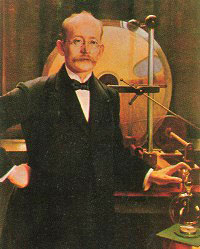
Heroic expeditions to observe
geomagnetic activity and auroras in northern Norway.
First to
propose that electric currents come from the Sun, flow into
Earth's upper atmosphere, and cause the auroras. Generated
artificial auroras in vacuum chambers with magnetized metal
spheres (see
Terrella) to represent the Earth.
His work was denigrated by the English mathematician Sydney
Chapman who argued for a model based on the kinetic theory of
neutral gases and a "dynamo" driven by tidal flows in the
ionosphere.
Chapman eventually had to admit he was wrong when Birkeland's model was shown correct through the use of high
altitude rockets and satellite technology, but his ideas persist
in atmospheric physics.
Discovered the twisted corkscrew-shaped paths taken by
high-intensity electric currents in plasma. Discovered that
electric currents in space tend to follow magnetic fields
("lines of force"), not cut across them (as suggested by the
Lorentz force term qv cross B).
Irving Langmuir

Discovered the "double sheath" or
"double layer" (DL) effect in plasmas.
Coined the term plasma to
describe the almost lifelike, self-organizing, self-sustaining
behavior of these ionized clouds in the presence of electric
currents, magnetic fields, and foreign bodies. These have
nothing to do with gas dynamics, to the eternal dismay of
experts in gas dynamics.
Among the many properties of plasmas he discovered: plasma
frequency.
The Langmuir probe, a laboratory tool still widely used.
Hannes Alfvén

Developed method of calculating the
motions of electrons and ions in magnetic fields.
First to
predict (1963) the large-scale filamentary structure of the
universe. Played central role in the development of plasma
physics, the physics of charged particle beams, and
interplanetary and magnetospheric physics.
Twenty years before the discovery of the Van Allen radiation
belt, developed the basic tools we use today to describe it.
Proposed mechanism explaining the acceleration of cosmic rays
now known as the Fermi Mechanism -- before Fermi. Fought for
years to make astronomers aware of the existence and importance
of electric fields and currents in space.
With his students, developed the theoretical and mathematical
foundation for the earlier experimental results of Birkeland and
Langmuir.
Was never able to change the mindset of most astrophysicists who
continue to follow the purely deductive mathematical approach
championed by Chapman and followers that ignores the importance
of electric currents and fields, treats plasmas as if they were
gases, and views as "flawed" any observations that conflict with
their models.
Anthony L. Peratt
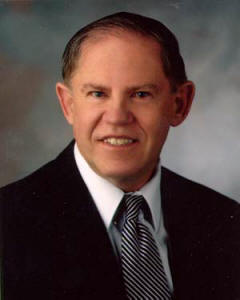
Computer simulations of galaxy
formation.
Published articles on Evolution of the Plasma
Universe and Formation of Systems of Galaxies. Edited special
issue of IEEE Transactions - a seminal publication that sets
out the fundamental basis of the Electrical/Plasma Universe.
Using an extremely large computer, applied the Maxwell-Lorentz
equations to each member of a huge ensemble of charged particles
- the Particle in Cell (PIC) simulation - generating images of
simulated galaxies almost indistinguishable from actual ones.
The gravitational effects in the PIC simulation were negligible.
Published The Physics of the Plasma Universe (Springer-Verlag
1992) showing why electrical effects canot be ignored in any
modern study of the cosmos.
Website:
The Plasma Universe
Wallace Thornhill
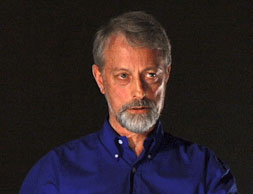
Development of plasma models of
astronomical objects and their features.
Website:
THUNDERBOLTS
New Cosmologies
Having problems believing in the big bang? Relax; you're in good
company...
An Open Letter to the Scientific Community
published in New
Scientist
May 22, 2004
from
CosmologyStatement Website
The big bang today relies on a growing number of hypothetical
entities, things that we have never observed-- inflation, dark
matter and dark energy are the most prominent examples.
Without them, there would be a fatal
contradiction between the observations made by astronomers and
the predictions of the big bang theory. In no other field of
physics would this continual recourse to new hypothetical
objects be accepted as a way of bridging the gap between theory
and observation.
It would, at the least, raise
serious questions about the validity of the underlying theory.
more...
There is no "Open SETI cosmology" but
conventional "Big Bang" cosmology is strongly contradicted by new
formulations of physics that seem to be candidates for inclusion in
an Open SETI paradigm.
Don Hotson points out that problems resulting from the Doppler
interpretation of red shifting led to the ad hoc invention of
expanding space, a phenomenon said to have begun with the Big Bang.
Among the many problems with the expanding space idea is that of
explaining how expanding space can actually move any material
object, going so far as to accelerate whole superclusters of
galaxies to 99% of the speed of light.
Hotson shows that light loses quanta of energy to the medium through
which it travels. This being the reason for observed red shifting,
there is no expansion of the universe requiring an initial magical
explosion.
In the open system of SQK, matter and energy formation at favored
"supercritical" locations in the vicinity of gravitational potential
wells gives rise to ever-growing structures spanning the hierarchy
from subatomic particles all the way to galactic superclusters. The
"genic energy" arising at the centers of all celestial bodies rather
inverts conventional concepts of the life cycles of stars and
galaxies.
While all these objects continue to grow
and to evolve up the hierarchy, lone photons and other particles
traveling through intergalactic space have a certain tendency to
degenerate back into the transmutive ether along the way. This makes
SQK a "tired-light cosmology" (like Hotson's and
Halton Arp's) and
resolves Olber's paradox (i.e., explains why the night sky is dark).
Tired-light cosmologies refute conventional redshift-age
associations and can lead to radically different estimates of
objects' ages and distances.
As with Hotson's physics, cosmogenesis in SQK is ongoing and there
is no big bang. Thus the age of the universe is indefinite if you
include the transmutive ether in your definition of "universe".
There are two important qualifiers to
this statement.
-
First, since the rate of
production of matter and energy grows exponentially (due to
the fact that it is favored in locations that already have
matter in them) the vast majority of the manifested universe
has come into being fairly recently; LaViolette suggests
ten-fifteen billion years, which compares well with
conventional estimates.
-
The second qualifier is that
LaViolette considers even the underlying ether to be "open"
in both directions, meaning that something even further
removed from our view may be stirring the pot by flowing
across an interface into it. So it could be that "something"
which set things going originally, causing the first
subatomic particles and energy potentials to appear as out
of the void, whenever they did.
SQK's explanation for our inability to
directly perceive the transmutive ether and its etherons with our
physical senses or our instruments is that we and our instruments
are composed of matter and energies that simply do not interact
directly with etherons.
It is concentrations and fluxes of
etherons that create our matter and fields.
The Model G equations
that describe these fluxes and dynamic interactions are not
necessarily the complete set of equations that may describe all etheron dynamics. It could very well be that other etheron states
could be associated with fluxes into other universes undetectable to
us. Note that such universes would occupy the same space and time
continua that we do; no matter, we still would not connect with
them.
Not, at least, with our present technology. Can you see how this,
along with other considerations of stellar evolution and the correct
distance to other celestial bodies, are important considerations for
SETI?
The complete story of these matters can be found in Subquantum
Kinetics (2003) and Genesis of the Cosmos: The Ancient
Science of Continuous Creation (2004). Both books are important
for understanding the full picture. Also see
Evidence Against the
Expanding Universe Hypothesis.
A major portion of Genesis of the Cosmos is devoted to the
concept that SQK is actually an ancient science, encoded for us in
well-known myths - for example, the Egyptian myth of Osiris, Isis,
Set, and Horus (representing etheron states and dynamics) as well as
the Hindu gods.
The very idea that greater wisdom and knowledge may
have been possessed by our ancient forebears is itself utterly at
variance with the beliefs of modern society, which of course
includes the beliefs of the SETI community.
But this idea has been a part of Open
SETI since the original Opening of SETI paper was conceived and
delivered in 1994. And this is why you are reading Open SETI.
Is it not so?
SETI, Take
Notice!
The topics discussed on this page are of course fascinating in
themselves, but they are also relevant to
Open SETI because
SETI calibrates its paradigm
according to what it perceives to be the limits on space travel and
communications.
So here we have a taste of developments
in physics and space technology that portend vastly changed
possibilities for travel and communications in space.
Surely the
next hundred years will see our own civilization gaining
capabilities scarcely dreamed of today. Yet what is possible for us
must be as nothing compared to the achievements of far older
civilizations.
If SETI is constructed on an opinion of
what is possible for a space-faring civilization, it surely needs to
track and EXTRAPOLATE the progress taking place in these fields.
|




 theory, which describes a common set of dynamic
interactions found in biological and social systems of every level
of complexity, might well be applicable to the world of subatomic
particles and whatever substrate may lie beyond the quantum level.
theory, which describes a common set of dynamic
interactions found in biological and social systems of every level
of complexity, might well be applicable to the world of subatomic
particles and whatever substrate may lie beyond the quantum level.







